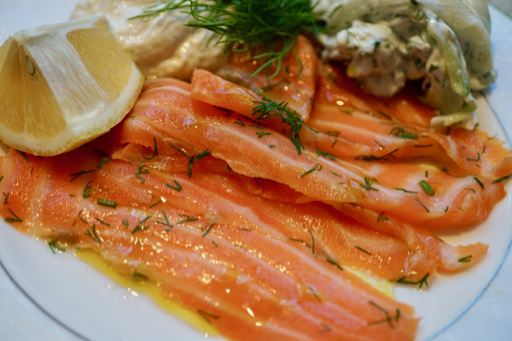We have been a big fan of pancakes; making so many different types over the years. Our division of labor is that my wife prepares the batter and I cook the pancakes. While we were browsing through YouTube, we came across "fluffy pancakes". We first saw a Korean version and then a Japanese version. We came across quite few recipes on line. The constant factor in all the recipes is separating the eggs yolk, whipping the white and incorporating it into the yolk, flour mixture. Then cooking the pancake on low flame with a cover or lid piling up more batter while it is cooking to give it height (or thickness). The differences among the recipes are the amount of sugar and eggs and type flours (either AP or cake flour). Also, we both remember making a type of fluffy pancake in which separated yolk and whipped egg white were folded into the batter but apparently we did not blog it or this was before we started our blog and we do not remember the details at all. So, one weekend, we made this fluffy pancake for lunch. We served the pancakes with a fried egg (using pasteurized eggs).

Our pancakes did not fluff up as much as seen in the YouTube videos but still pretty fluffy. For the sake of picture taking, we served three pancakes but we divided this up and we each ate one and half pancakes.
My wife came up with a reasonable hybrid of all the recipes she browsed.
Ingredients (makes three small pancakes):
1 egg, yolk and white separated
1 tsp (5g) sugar
2 tbs (20g) milk (we used light cream)
1 tbs (10g) vegetable oil
4 tbs (32g) cake flour
2/3 tsp baking powder
A pinch of salt
A dash of vanilla extract
Ingredients (X 2 makes 6 small pancakes):
2 egg, yolk and white separated
2 tsp (10g) sugar
4 tbs (40g) milk (we used light cream)
2 tbs (20g) vegetable oil
8 tbs (64 g) cake flour
1 1/3 tsp baking powder
A pinch of salt
A dash of vanilla extract
Directions:
Mix the egg yolk, sugar, milk, and oil in a bowl with whisk until foamy and well mixed (#1).
Add the cake flour and mix until incorporated.
In a stand mixer, whip the egg white to hard peak
Add 1/3 to the flour egg yolk mixture and mix using a whisk (#2), fold in the remaining egg white using a spatula.
Meanwhile preheat a non-stick frying pan on low flame for 10-15 minutes and melt butter, spoon in the batter (#3) and put a lid on. After few minutes, add more batter on the top to make it thicker.
After 10-15 minutes, turn the pancakes over (#4) and cook another 5 minutes with a lid on.
When we had this, I had a
Proust's "Madeleine" moment. The texture and taste of these pancakes transported me back to Sapporo 札幌 when I was a kid and my father took me and my brother (don't tell Mother) to an ice cream parlor*. This pancake really reminded me of those pancakes (they were called hotcakes back then. It appears that they still serve them but they are now called
pancakes). Next time when we go back to Sapporo, we have to go there and try the pancakes. As to this version, this is our first attempt at this. We will certainly try to perfect this recipe.
* This was called "Yuki-jirushi" parlor
雪印パーラー. (The picture shows the old location which I visited as a kid). It was run by a big dairy company in Hokkaido. It is still in operation. It moved from the original location to its current location in a nearby building in April, 2017. Until then, it was at the same place we went to as a kid so many years ago.






























